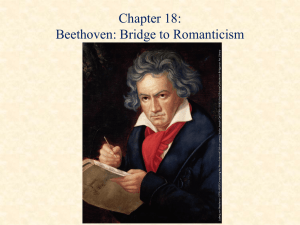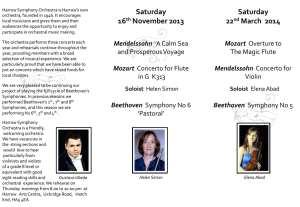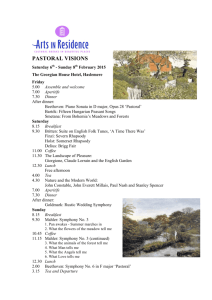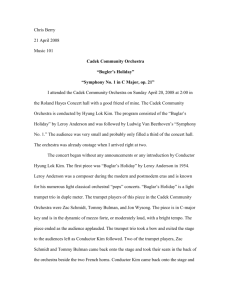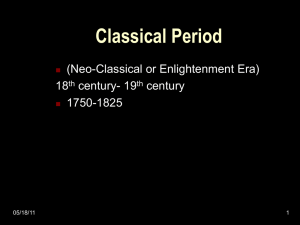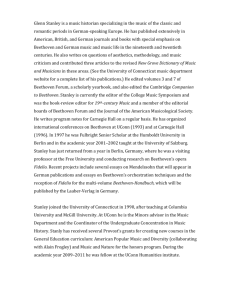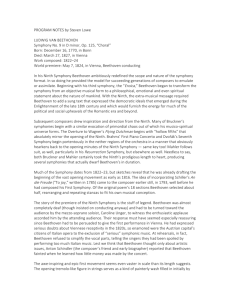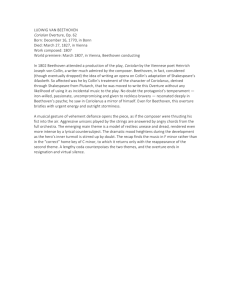For Adults – English/Spanish
advertisement
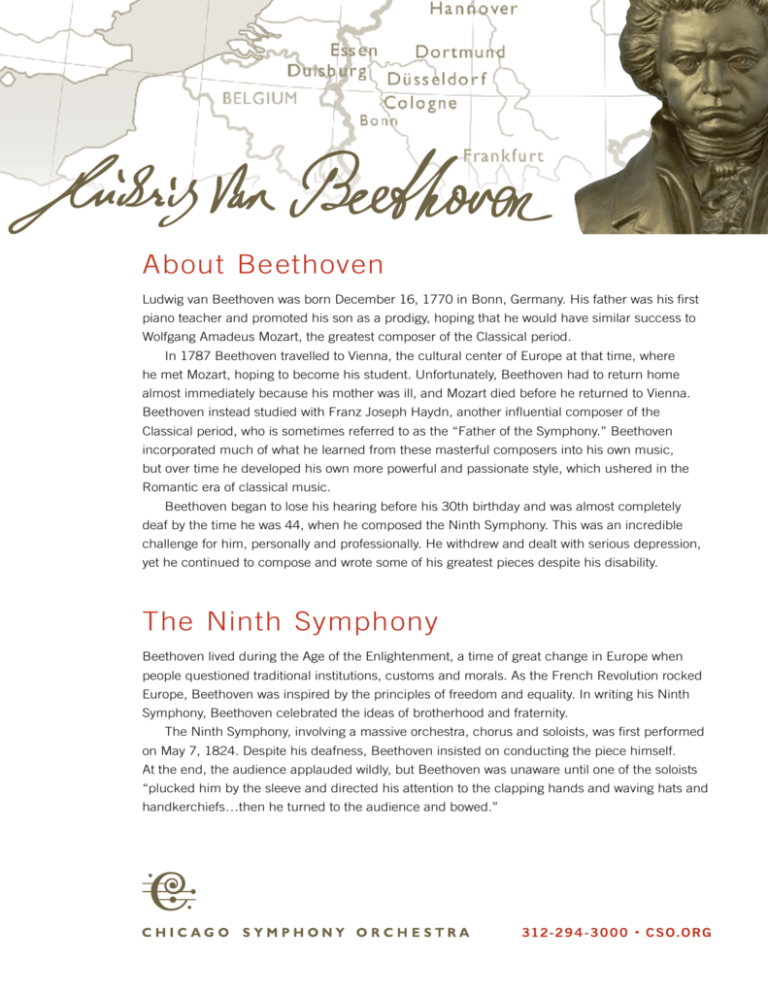
About Beethoven Ludwig van Beethoven was born December 16, 1770 in Bonn, Germany. His father was his first piano teacher and promoted his son as a prodigy, hoping that he would have similar success to Wolfgang Amadeus Mozart, the greatest composer of the Classical period. In 1787 Beethoven travelled to Vienna, the cultural center of Europe at that time, where he met Mozart, hoping to become his student. Unfortunately, Beethoven had to return home almost immediately because his mother was ill, and Mozart died before he returned to Vienna. Beethoven instead studied with Franz Joseph Haydn, another influential composer of the Classical period, who is sometimes referred to as the “Father of the Symphony.” Beethoven incorporated much of what he learned from these masterful composers into his own music, but over time he developed his own more powerful and passionate style, which ushered in the Romantic era of classical music. Beethoven began to lose his hearing before his 30th birthday and was almost completely deaf by the time he was 44, when he composed the Ninth Symphony. This was an incredible challenge for him, personally and professionally. He withdrew and dealt with serious depression, yet he continued to compose and wrote some of his greatest pieces despite his disability. The Ninth Symphony Beethoven lived during the Age of the Enlightenment, a time of great change in Europe when people questioned traditional institutions, customs and morals. As the French Revolution rocked Europe, Beethoven was inspired by the principles of freedom and equality. In writing his Ninth Symphony, Beethoven celebrated the ideas of brotherhood and fraternity. The Ninth Symphony, involving a massive orchestra, chorus and soloists, was first performed on May 7, 1824. Despite his deafness, Beethoven insisted on conducting the piece himself. At the end, the audience applauded wildly, but Beethoven was unaware until one of the soloists “plucked him by the sleeve and directed his attention to the clapping hands and waving hats and handkerchiefs…then he turned to the audience and bowed.” 312-29 4 -30 0 0 • C S O.O RG Listen before the concer t ! The symphony is in four movements. Below is a description of highlights of each movement. Look for the red icon to listen to tracks on Spotify®. Just click the icon! Free account required. MOVEMENT 1 Allegro ma non troppo MOVEMENT 4 Presto: Allegro assai The symphony begins in an unusual The famous theme “Ode to Joy” makes this way, growing gradually from absolute movement one of the most recognizable silence to a peak over 16 measures. in all of classical music. This opening is reflective of his internal 3:28 as it’s played for the first time. Listen to 3:00- struggles—his hearing loss, his difficulty with communicating and his struggle to This movement is also unique because of compose music. As you listen, consider Beethoven’s use of a chorus. Beethoven’s state of mind while writing for it at 8:07 and 13:40. The text that the piece, and see if you can hear how Beethoven used comes from a poem he represented his personal challenges that he had long wanted to set to music, in the music. Friedrich Schiller’s “Ode to Joy.” In his Listen to 0:00-0:59. Listen poem, Schiller states that in a new age MOVEMENT 2 Scherzo: Molto vivace the old ways will no longer divide people and that “all men become brothers.” This idea of universal brotherhood appealed This movement is a Scherzo, the Italian to Beethoven so much that he wanted to musical term for “joking or playful.” celebrate it in his greatest symphony. Though it opens in a rather serious way, listen to the contrasting section from 4:59-6:11 for the playful tone Beethoven uses in the music. Notice the way that he cleverly weaves the melodic lines between instruments, while still maintaining a joking character represented by the rhythmic ideas he uses, and the staccato walking accompaniment. Joy, brilliant spark of the gods, daughters of Elysium, heavenly being, we enter your sanctuary intoxicated with fire. Your spells reunite that which was strictly MOVEMENT 3 Adagio molto e cantabile The tempo, or the speed of the music, is much slower than the previous movement. Listen for the deliberate motion of each note in the following selection (1:452:30). The contrast between the second movement and the following movement is very important. divided by convention; all men become brothers where your gentle wing rests. Prepare for Your Visit If this is your first time visiting Symphony Center, there are a few important pieces of information we would like to share with you to help you enjoy your experience. You will most likely enter Symphony Center at 220 S. Michigan Avenue. Before you enter, look up to see the names of five composers engraved in the stone façade above the arched windows on the second floor: Bach, Mozart, Beethoven, Schubert and Wagner. These composers were cornerstones of the orchestral tradition when Orchestra Hall was built in 1904, and it is not a coincidence that Beethoven is at the center. When you enter the building, a friendly CSO usher may greet you. Look for them in the red jackets. They can help you find your seats, direct you to the closest restroom or water fountain and answer any questions you may have. If you have time before or after the concert, walk down the Arcade on the first floor to view portraits of the musicians and see the Rotunda. When you enter Orchestra Hall to find your seats, you will notice musicians warming up on stage. A few minutes before concert time, the Chicago Symphony Chorus will enter and take their seats. Just before the concert is scheduled to start, the concertmaster (first chair of the first violin section) will take the stage and direct the principal oboist to lead the orchestra in tuning. When the orchestra is ready the lights will come down and the conductor, Maestro Riccardo Muti, and four vocal soloists will enter. And then the concert starts! Beethoven’s Symphony No. 9 is approximately seventy minutes long and is made up of four movements. The concert will be performed without an intermission. It is customary to hold your applause until the very end of the concert. You will know the performance is over when the conductor turns to face the audience. Look in your program book for a listing of the musicians of the CSO, bios of select musicians, English translations of the text for the choral sections of the symphony and much more. About the CSO Founded in 1891, the Chicago Symphony Orchestra is considered one of the greatest orchestras in the world. It is made up of 108 of the best musicians from across the globe who come to Chicago just to play in our amazing orchestra. The orchestra is led by Music Director Riccardo Muti, a renowned Italian conductor who leads concerts throughout the season and who helps to plan the music that the orchestra will play. The CSO performs more than 150 concerts each year at Symphony Center, as well as summer performances at the Ravinia Festival in Highland Park and sold-out tour performances in the United States and around the world. Through the Negaunee Music Institute, the CSO engages nearly 200,000 Chicagoarea residents annually. Music lovers outside Chicago enjoy the sounds of the CSO through its weekly CSO Radio Broadcast Series on 98.7 FM and recordings on its inhouse record label, CSO Resound. If you have questions about your upcoming visit to Symphony Center, please contact the Negaunee Music Institute at 312-294-3410 or institute@cso.org.
